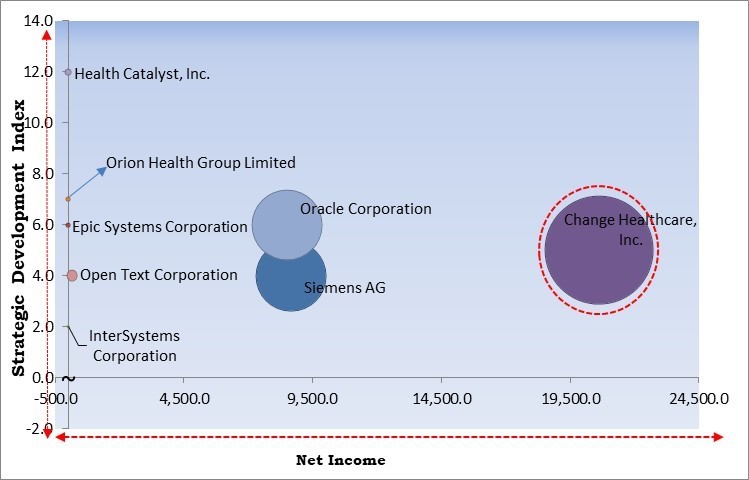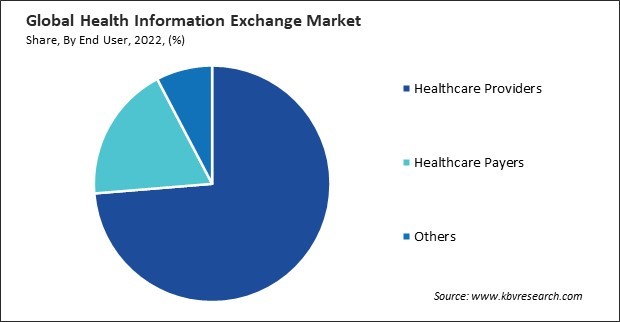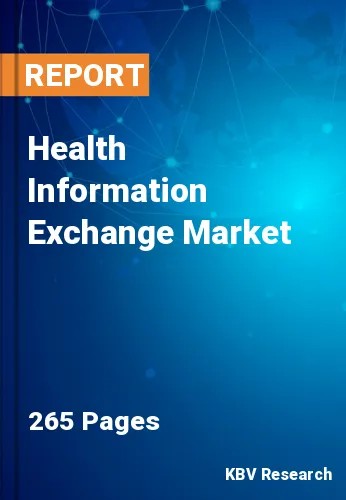“Global Health Information Exchange Market to reach a market value of USD 2.9 Billion by 2030 growing at a CAGR of 9.4%”
The Global Health Information Exchange Market size is expected to reach $2.9 billion by 2030, rising at a market growth of 9.4% CAGR during the forecast period.
Many countries in the Asia-Pacific region are increasingly adopting healthcare IT solutions to modernize their healthcare systems. As healthcare organizations digitize patient records and clinical data, there is a growing need for HIE platforms to facilitate seamless data exchange and interoperability among disparate healthcare systems and providers. Consequently, the Asia Pacific region would acquire nearly 20% of the total market share by 2030. For instance, as digital healthcare adoption accelerates, the demand for HIE solutions that enable interoperability, data exchange, and integration of digital health technologies is expected to increase, driving innovation and collaboration across the healthcare ecosystem. HIE platforms are crucial in supporting India's digital health transformation efforts and advancing the delivery of quality healthcare services to the population.

The major strategies followed by the market participants are Partnerships as the key developmental strategy to keep pace with the changing demands of end users. For instance, in December, 2023, Epic Systems Corporation announced an integration partnership with Qualtrics. The partnership aimed at helping providers offer more personalized healthcare experiences by facilitating them by combining patients' experience data from Qualtrics with health information in Epic. Moreover, in November, 2023, Siemens Healthineers, a subsidiary of, Siemens AG signed a partnership with SAP. The partnership aimed at driving Siemens Healthineers' digital transformation by utilizing SAP's cutting-edge cloud capabilities with Siemens Healthineers RISE platform.
Based on the Analysis presented in the KBV Cardinal matrix; Change Healthcare, Inc. is the forerunner in the Market. In January, 2019, Change Healthcare, Inc. came into partnership with Experian Health. The partnership aimed to resolve patient identity issues that were faced by both providers and payers by integrating Change Healthcare’s Intelligent Healthcare Network with Experian Health’s robust identity management capabilities. The partnership facilitates accurately identifying and matching patient records across various healthcare organizations. Companies such as Oracle Corporation, Siemens AG and Open Text Corporation are some of the key innovators in Market.

To mitigate the potential for pathogen transmission and streamline face-to-face interactions, healthcare providers swiftly ramped up the implementation of telehealth and remote care solutions. This increased reliance on virtual care services drove demand for HIE solutions that enable secure exchange of patient information between healthcare providers, facilitating coordinated care delivery across virtual and traditional care settings. Moreover, HIEs supported public health surveillance efforts by aggregating and analyzing health data to monitor COVID-19 trends, identify hotspots, and allocate resources more efficiently. HIE networks enabled healthcare organizations to report COVID-19 cases, outcomes, and vaccination data to public health agencies, supporting government response efforts and informing policy decisions related to pandemic management. Thus, the COVID-19 pandemic positively impacted the market.
Population health management relies heavily on aggregating and analyzing health data from various sources, including electronic health records, claims data, public health databases, and social determinants of health. Moreover, HIE platforms enable healthcare providers to access real-time patient data, clinical guidelines, and decision support tools at the point of care, enhancing their ability to make informed clinical decisions and deliver evidence-based interventions tailored to individual patient needs. Hence, enhanced population health management is driving the growth of the market.
HIE platforms facilitate the secure and interoperable exchange of patient information among healthcare providers, encompassing medical history, diagnostic test outcomes, medications, and treatment strategies. Moreover, enhanced coordination of care facilitated by HIEs contributes to mitigating patient safety incidents, adverse drug reactions, and medical errors by ensuring that healthcare providers have immediate access to accurate information. Therefore, improved coordination of care is propelling the growth of the market.
Implementing an HIE system involves significant upfront costs related to acquiring hardware, software, and infrastructure and hiring IT professionals and consultants to design, deploy, and configure the system. Moreover, achieving seamless interoperability among different EHR systems, healthcare IT platforms, and data sources requires additional data standardization, interface development, and testing investments. Thus, the high cost of implementation and maintenance is hampering the market's growth.
On the basis of the implementation model, the market is segmented into hybrid, centralized, and decentralized/federated. In 2022, the decentralized/federated segment attained a noteworthy revenue share in the market. Decentralized or federated HIE models give healthcare organizations greater control over their data and information-sharing processes. This allows them to maintain ownership of patient health records while participating in a broader network for data exchange. Healthcare providers can adhere to their organization's data governance policies and compliance requirements, ensuring data integrity, privacy, and security.
By end user, the market is divided into healthcare providers, healthcare payers, and others. The healthcare payers segment procured a remarkable revenue share in the market in 2022. HIE solutions enable healthcare payers to enhance care coordination and management for their members by facilitating real-time access to clinical data, treatment histories, and care plans. Payers can collaborate with providers to identify gaps in care, implement preventive interventions, and monitor care transitions to ensure seamless continuity of care across healthcare settings.

Based on setup type, the market is categorized into private and public. The public segment witnessed a remarkable revenue share in the market in 2022. Public HIE networks aim to provide inclusive access to these services for healthcare organizations, regardless of size, resources, or technical capabilities. Most public HIE initiatives leverage government funding, grants, and subsidies to establish and operate HIE networks accessible to various stakeholders, including hospitals, clinics, pharmacies, and public health agencies.
Based on exchange type, the market is divided into directed exchange, query-based exchange, and consumer-mediated exchange. In 2022, the query-based exchange segment attained a substantial revenue share in the market. The query-based exchange allows healthcare providers to request specific patient information from other organizations in real-time. This facilitates immediate access to relevant medical records, test results, and treatment histories, enabling informed clinical decision-making and timely care delivery. Furthermore, query-based exchange streamlines communication and collaboration among healthcare providers by enabling them to query patient data from disparate sources.
Free Valuable Insights: Global Health Information Exchange Market size to reach USD 2.9 Billion by 2030
Region-wise, the market is analyzed across North America, Europe, Asia Pacific, and LAMEA. The North America region witnessed the maximum revenue share in the market in 2022. The North American healthcare landscape is heavily influenced by regulatory mandates that encourage or require adopting HIE solutions. Healthcare organizations are incentivized to adopt HIE capabilities through programs like the Centers for Medicare & Medicaid Services Promoting Interoperability Program and the Health Information Technology for Economic and Clinical Health (HITECH) Act. Improving care coordination, patient outcomes, and data interoperability are the principal aims of these initiatives.
| Report Attribute | Details |
|---|---|
| Market size value in 2022 | USD 1.5 Billion |
| Market size forecast in 2030 | USD 2.9 Billion |
| Base Year | 2022 |
| Historical Period | 2019 to 2021 |
| Forecast Period | 2023 to 2030 |
| Revenue Growth Rate | CAGR of 9.4% from 2023 to 2030 |
| Number of Pages | 265 |
| Number of Tables | 433 |
| Report coverage | Market Trends, Revenue Estimation and Forecast, Segmentation Analysis, Regional and Country Breakdown, Competitive Landscape, Porter’s 5 Forces Analysis, Company Profiling, Companies Strategic Developments, SWOT Analysis, Winning Imperatives |
| Segments covered | Setup Type, Exchange Type, Implementation Model, End User, Region |
| Country scope |
|
| Companies Included | Change Healthcare, Inc. (Optum, Inc.) (UnitedHealth Group, Inc.), Chetu, Inc., Siemens AG, Epic Systems Corporation, Oracle Corporation, Orion Health Group Limited, Health Catalyst, Inc., Open Text Corporation, Infor, Inc. (Koch Industries) and InterSystems Corporation |
By Setup Type
By Exchange Type
By Implementation Model
By End User
By Geography
This Market size is expected to reach $2.9 billion by 2030.
Impact of enhanced population health management are driving the Market in coming years, however, High cost of implementation and maintenance restraints the growth of the Market.
Change Healthcare, Inc. (Optum, Inc.) (UnitedHealth Group, Inc.), Chetu, Inc., Siemens AG, Epic Systems Corporation, Oracle Corporation, Orion Health Group Limited, Health Catalyst, Inc., Open Text Corporation, Infor, Inc. (Koch Industries) and InterSystems Corporation
The expected CAGR of this Market is 9.4% from 2023 to 2030.
The Private segment generated the highest revenue in the Market by Setup Type in 2022; there by, achieving a market value of $1.6 Billion by 2030.
The North America region dominated the Market by Region in 2022, and would continue to be a dominant market till 2030; there by, achieving a market value of $1.3 Billion by 2030.
Our team of dedicated experts can provide you with attractive expansion opportunities for your business.

 Drivers
Drivers
 Restraints
Restraints
 Opportunities
Opportunities
 Challenges
Challenges
